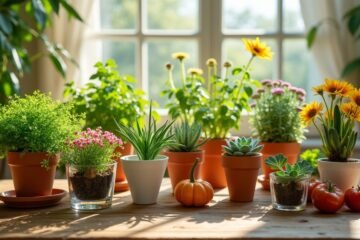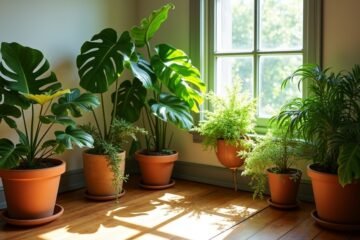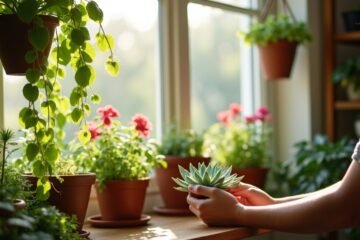Want to spark your child’s interest in gardening? Start a mini vegetable garden—it’s like magic! Just loosen the soil, sprinkle some vibrant seeds, and watch them grow! Or, try planting flower seeds in eggshells; they’re nature’s tiny pots! How about a whimsical fairy garden with enchanting plants and quirky gnomes? Don’t forget to make a butterfly haven with colorful nectar plants. Each project brings laughter, wonder, and a bit of dirt—stick around for more fun ideas!
Starting a Mini Vegetable Garden
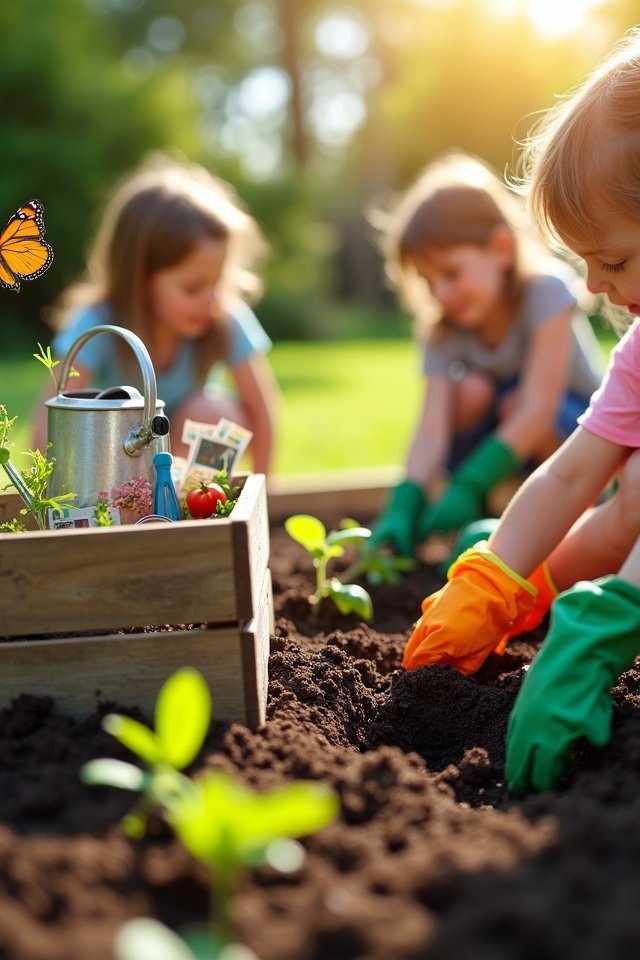
Starting a mini vegetable garden is an exciting adventure, especially when you realize how much fun it can be to grow your own snacks right in your backyard! First, you’ll need to plunge into soil preparation—think of it as giving your plants a cozy bed to snuggle in. Loosen the earth, add compost, and watch it transform into a nutrient-rich paradise! Next, it’s all about seed selection. Choose vibrant seeds like cherry tomatoes or crunchy cucumbers. Picture biting into a fresh, sun-kissed tomato that you nurtured yourself! Don’t forget to space them out; they need room to stretch and grow. With a little care and creativity, your mini garden will bloom into a delicious retreat that’ll impress your friends and family!
Planting Flower Seeds in Eggshells
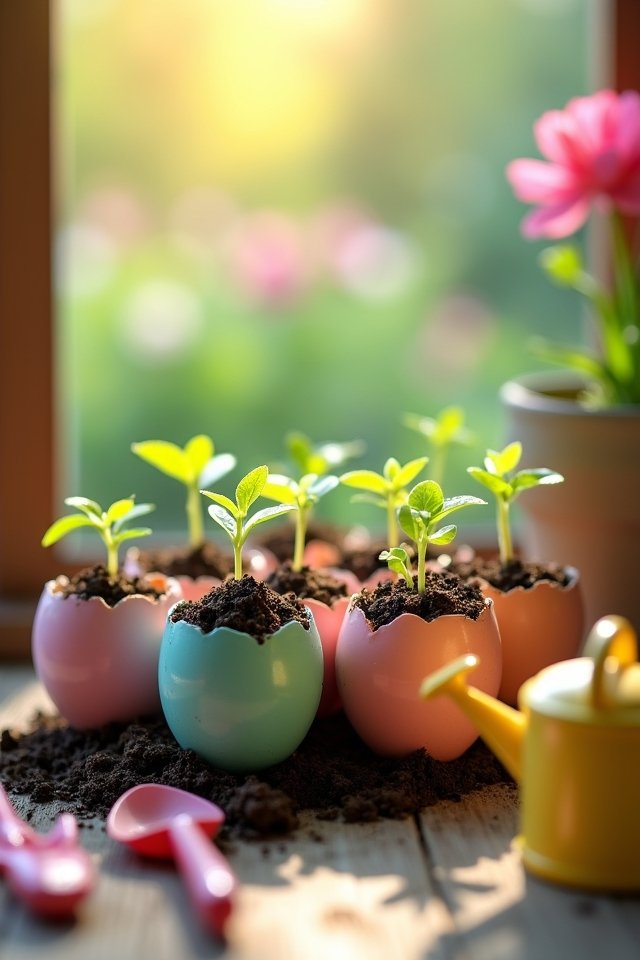
Have you ever thought about using eggshells to plant flower seeds? It’s a fun and eco-friendly way to kick off your gardening adventure! Not only do you get to use those shells that usually end up in the trash, but they also provide essential eggshell nutrients for your sprouting flowers. Here’s how to get started:
- Prepare the Eggshells: Carefully crack the shells in half and rinse them out, leaving the bottoms intact.
- Add Soil and Seeds: Fill each shell with potting soil, then place a few flower seeds in. Don’t forget to water them!
- Watch for Germination: Place them in a sunny spot and enjoy the magic of seed germination as they sprout into vibrant blooms!
What a delightful way to brighten your space!
Creating a Fairy Garden
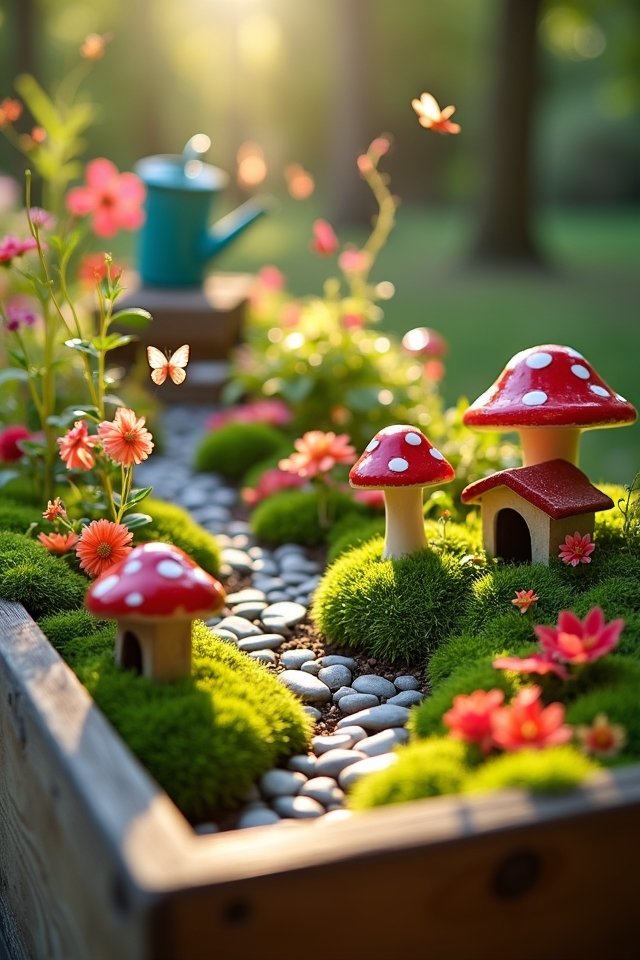
Creating a fairy garden is like stepping into a whimsical world where imagination takes flight! You can craft a magical oasis right in your backyard. Start with a small container or a corner of your garden, then choose enchanting plants like mini succulents or colorful dwarf flowers. These magical plant choices will create a lush environment for your fairy friends!
Next, sprinkle in some fairy garden accessories like tiny houses, shimmering pebbles, and charming bridges. Don’t forget the quirky gnomes! You’ll be amazed at how these delightful details bring your garden to life. As you dig and decorate, think about the stories your fairies might tell! So, grab your tools, release your creativity, and let the fairy fun begin!
Making a Butterfly Garden
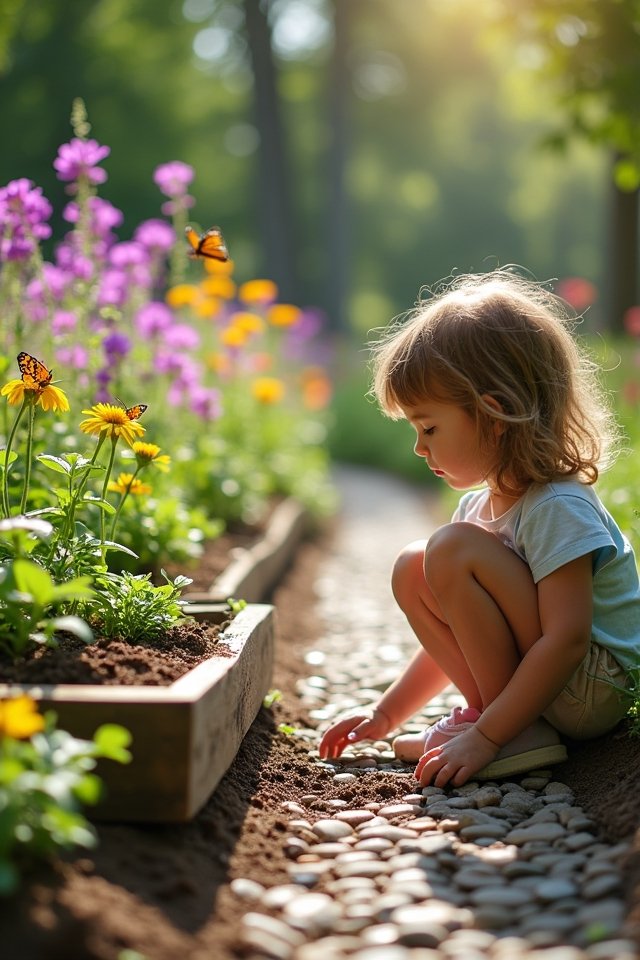
If you think fairies fluttering around your garden is enchanting, just wait until you see butterflies dancing through the flowers! Creating a butterfly garden is a fantastic way to invite beautiful butterfly species into your backyard. Here’s how to get started:
- Choose nectar plants: Select colorful flowers like milkweed, coneflowers, and lantanas that provide food for hungry butterflies.
- Create sunny spots: Butterflies love warmth! Find sunny, open areas for them to bask in the sun.
- Add shelters: Plant shrubs or small trees where butterflies can hide from wind and predators.
With a little creativity and care, your garden will be alive with fluttering wings and joyful colors, turning your space into a magical haven!
Building a Simple Compost Bin
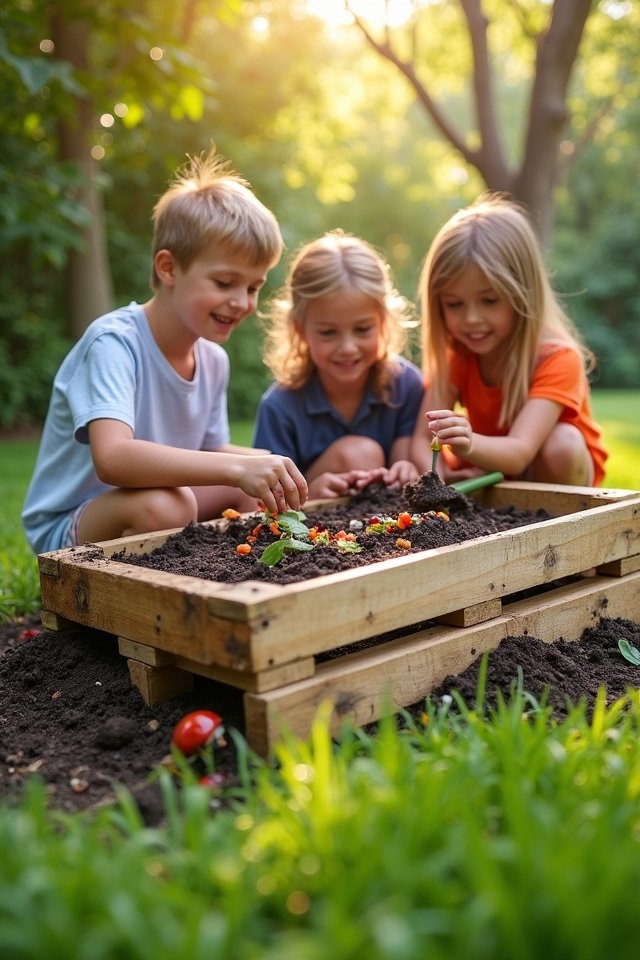
Building a simple compost bin can be one of the most rewarding projects for your garden! You’re not just tossing scraps into a pile; you’re creating “black gold” for your plants! Start with easy bin materials like wooden pallets or wire mesh. It’s like giving your kitchen scraps a second chance at life! Layer your greens—like veggie peels—and browns—like dried leaves—and watch the magic happen. Compost benefits include rich soil that makes your plants thrive, plus it helps reduce waste. Who knew trash could turn into treasure? Remember, turning the pile now and then speeds up decomposition, and you’ll soon have nutrient-packed compost to boost your garden’s health! Isn’t nature amazing? Let’s get composting!
Painting Pots for Flower Planting
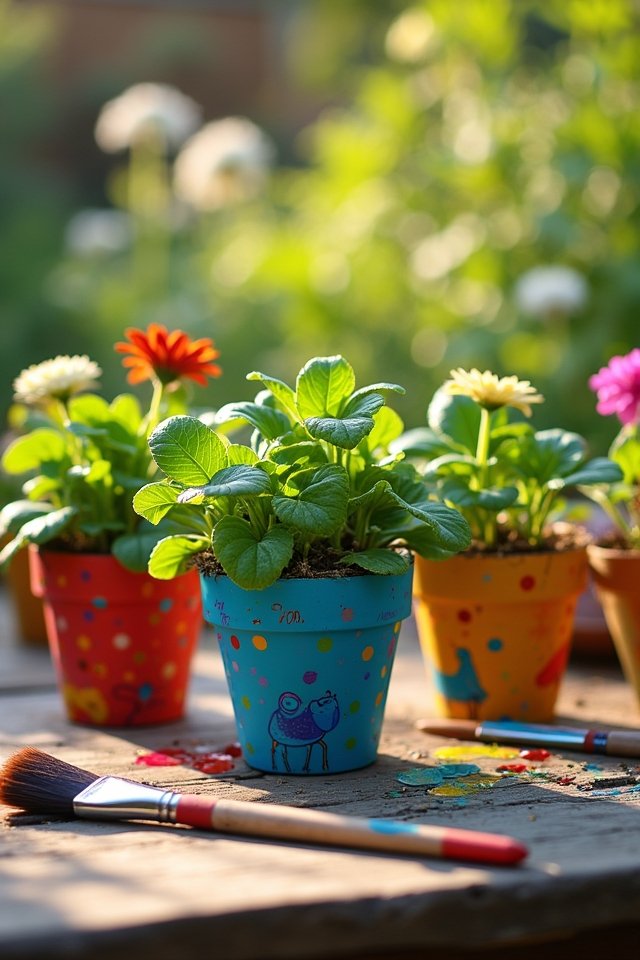
After you’ve whipped up some nutrient-packed compost, it’s time to give your flower pots a fabulous makeover! Let your creativity run wild with stunning pot designs that’ll make your flowers shine brighter. Grab your brushes and choose some fun paint techniques, like sponging or splattering, to create unique patterns. Here’s what you’ll need:
- Terracotta pots—perfect for painting!
- Non-toxic acrylic paints—vibrant and safe for kids!
- Paintbrushes and sponges—your tools for artistic expression!
Don’t hesitate to mix colors, or even add glitter for that extra sparkle! Think of each pot as a canvas where your imagination can bloom. So, what are you waiting for? Let’s transform those plain pots into eye-catching masterpieces!
Growing Herbs in Small Containers
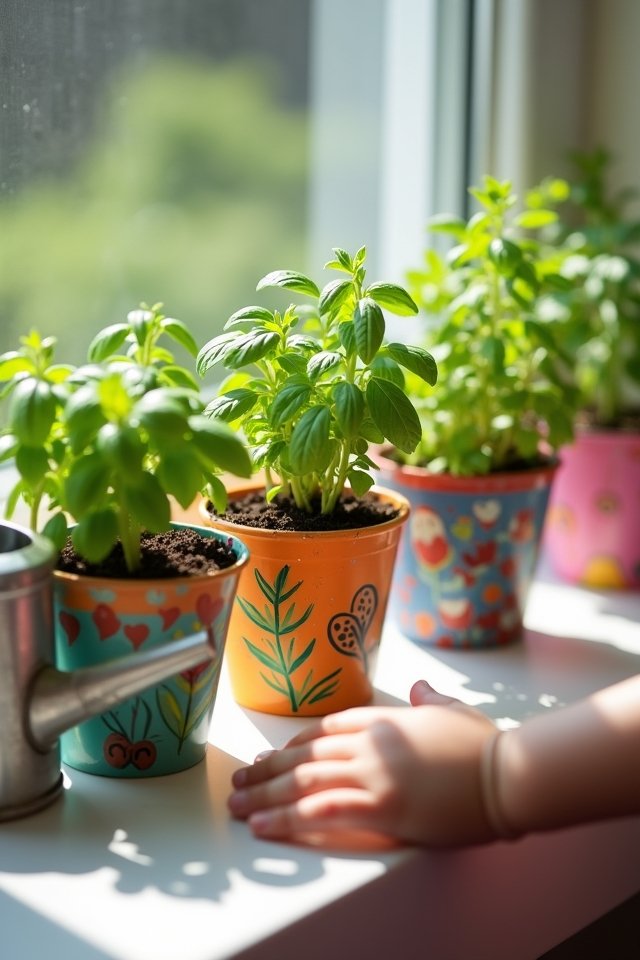
Growing herbs in small containers is not just fun, it’s like having your very own mini garden right on your windowsill! Picture fresh basil, zesty cilantro, or fragrant mint, all at your fingertips. Choose container sizes that fit your space—tiny pots for single herbs, or larger ones for a vibrant herb trio. Don’t worry about space; even the smallest kitchen can host a flavorful herb collection! Mix and match herb varieties to create a colorful, aromatic display. Just imagine snipping off a sprig of rosemary for your dinner! Plus, caring for these little green wonders is a breeze, and you’ll be amazed at how they thrive. Who knew gardening could be so delightful and rewarding?
Setting Up a Nature Scavenger Hunt

Ready for an adventure? Setting up a nature scavenger hunt is a fantastic way to ignite your kids’ curiosity and promote nature exploration! Just imagine their eyes lighting up as they search for hidden treasures in your backyard or a nearby park. Here’s how to get started:
- Create a List: Include items like a pinecone, a feather, or a unique rock.
- Set Boundaries: Define the area where your little explorers can roam freely, keeping safety in mind.
- Make It Fun: Add a point system for each find; extra points for the rarest items!
This outdoor adventure will inspire creativity, teamwork, and a love for nature! So, grab your scavenger hunt checklist and let the exploration begin!
Designing a Garden for Wildlife

Imagine stepping into a garden buzzing with life, where vibrant butterflies flit from flower to flower and cheerful birds chirp their morning songs! Designing a garden for wildlife is like painting a masterpiece of nature. Start by planting native flowers that attract pollinators, creating a colorful buffet! Add bird feeders filled with seeds, turning your space into a feathered dining hall. Don’t forget water sources, like a small pond or birdbath, to quench their thirst. You can even incorporate logs and stones for habitat restoration, giving critters cozy nooks to call home. With a little creativity and care, your garden becomes a thriving ecosystem. Are you ready to invite nature’s friends to your backyard party? Let’s get started!
Creating Garden Markers With Craft Supplies

Crafting garden markers with fun craft supplies is an awesome way to add personality to your garden! You’ll not only keep your plants organized but also release your creativity. Let’s plunge into making some unique markers!
- Popsicle Sticks: Paint them in vibrant colors and write the plant names with a permanent marker. They’re like mini canvases for your garden!
- Stone Markers: Collect smooth stones, then use acrylic paint for your creative marker designs. It’s nature’s way of blending art and gardening!
- Wine Corks: Stick a toothpick into each cork, label them, and voilà! Your garden just got a chic upgrade.
Frequently Asked Questions
What Gardening Tools Are Safe for Kids to Use?
Choosing gardening tools for kids is like picking the right paintbrush for a masterpiece! You want child-friendly tools that spark creativity and guarantee gardening safety. Look for lightweight trowels, colorful gloves, and small watering cans—perfectly sized for tiny hands. A fun, kid-sized rake can transform yard work into a mini-adventure! Remember to supervise them, turning their green thumbs into a blooming passion while keeping safety at the forefront. Isn’t that a delightful thought?
How Can We Make Gardening More Fun for Children?
To make gardening more fun for kids, why not turn it into an adventure? You can create garden games like scavenger hunts, where they search for colorful flowers or unique bugs! Use creative containers, like painted tin cans or old boots, to plant flowers—imagine the joy when they see their quirky garden! It’s all about making it playful. Who wouldn’t want to dig in the dirt and watch their colorful creations bloom? Let’s get started!
What Are the Best Plants for Kids to Start With?
Imagine a rainbow sprouting in your backyard! For kids, easy herbs like basil and mint are perfect starters; they’re as simple as pie and smell divine! Colorful flowers, such as marigolds and zinnias, add splashes of joy and attract butterflies, turning your garden into a magical wonderland. Isn’t that exciting? Kids can dig in, feel the soil, and watch their creations bloom—it’s like crafting nature’s artwork! Who wouldn’t want to plunge into that adventure?
How Much Sunlight Do Plants Need for Healthy Growth?
Plants, like sunbathers, thrive on sunlight! Most need about six to eight hours a day for healthy growth. Think of it as their daily dose of vitamin D! Some, like succulents, love a full sunbath, while others, like ferns, prefer dappled light. Monitor your plants—if they’re stretching for the light, they need more! Remember, too much sun can fry those green leaves, so keep an eye out! Happy growing!
What Should We Do if Pests Damage Our Plants?
Got pests munching on your plants? Don’t panic! You can use natural pest control methods that are as effective as they are friendly to the environment. Try sprinkling diatomaceous earth, a powder that looks like fairy dust, around your plants. Or, mix garlic and water to create a stinky spray that bugs hate! These organic solutions not only help your plants thrive but also keep your garden buzzing with life! Isn’t nature amazing?
